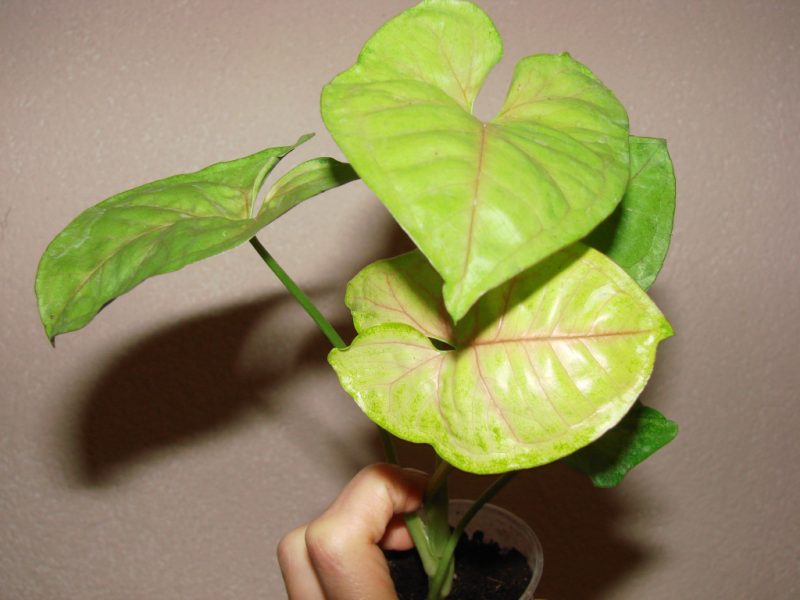Syngonium from the aroid family is an evergreen perennial that lives in the tropical zones of South and Central America and uses powerful tree trunks as a support. A flower with high decorative qualities has become widespread in indoor floriculture due to its graceful shoots and bright leaf plates.
Material Content:
Syngonium: types, varieties and description
The plant is represented by thin shoots on which aerial roots cling to a support are formed. Young creepers have holistic leaves. arrow-shaped form, which becomes dissected as it ages. The color of the sheet plates can be either monophonic or with various patterns in the form of spots and strokes. Flowers are represented by cob-shaped inflorescences wrapped in bedspreads.

In the wild, the genus has about 30 species, but only three varieties are grown in indoor floriculture:
- Syngonium Legate - a highly branched vine with a graceful stem and dark green leaves on long stalks. The intensive growth of the species, which became the basis for breeding many varieties, is confirmed by an annual growth of up to 60 cm. Famous varieties: dwarf Pixie with variegated leaves, undemanding White Butterfly, characterized by fast growth rates and large leafy plates.
- Syngonium ear - a creeper plant up to 2 m tall with a thin stem and aerial roots developing from internodes.Glossy leaf plates are attached to the shoots using long (up to 40 cm) petioles. The growth per year can reach 90 cm.
- Syngonium Wendland - the view is represented by plants with velvety, dissected into three segments by leaf plates. The high degree of decorativeness of the species creeper exceeds the most spectacular varieties of leg-leaved syngonium.
Features of growing plants

When growing a tropical plant at home, the following parameters must be considered:
- Flowering - in a room environment the plant does not bloom.
- Toxicity - the syngonium milky juice irritates the mucous surface, so you can’t put the flower in places accessible to children and animals.
- The pace of development and growth - to grow a flower, you need to choose a spacious place.
- Thermophilic - Do not let the temperature drop below 16 ° C.
- Photophilicity - the need for a long daylight in winter makes it necessary to install an artificial light source.
Caring for syngonium at home
In order for an exotic plant to please the grower with a healthy look and decorate the interior of the room with beautiful and lush greenery, it is necessary to follow simple rules for care.
Location and lighting

For a flower that loves a large amount of scattered light, window sills of the western or eastern windows are selected, where the possibility of direct sunlight being excluded is excluded. In winter, with a short daylight, the flower is organized with additional lighting using fluorescent lamps. Otherwise, the leaf plates begin to fade, which leads to a loss of decorativeness.
Temperature
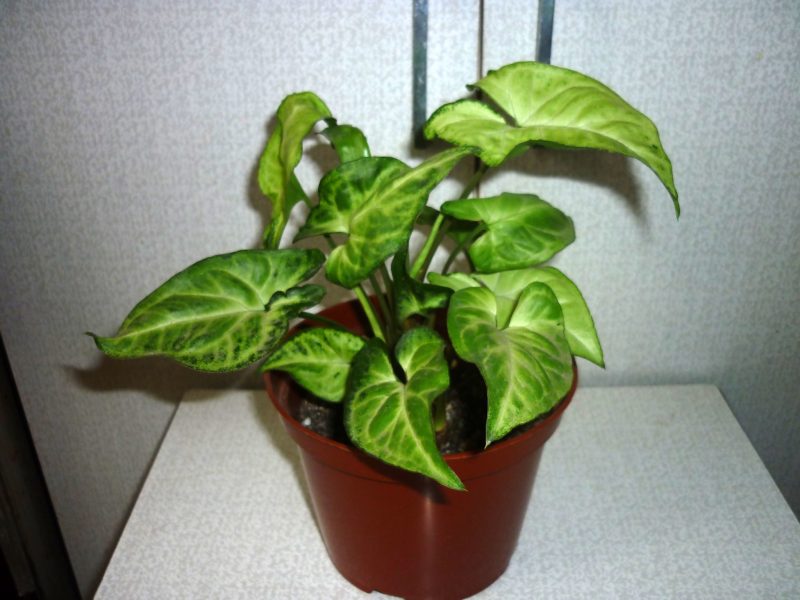
In the period of active vegetation occurring in the spring-summer period, the optimum temperature is 20-22 ° C. With the advent of winter, the thermometer may drop by 2-3 ° C.
Important! A thermophilic vine can suffer when the temperature drops below a value of 16 ° C.
Air humidity
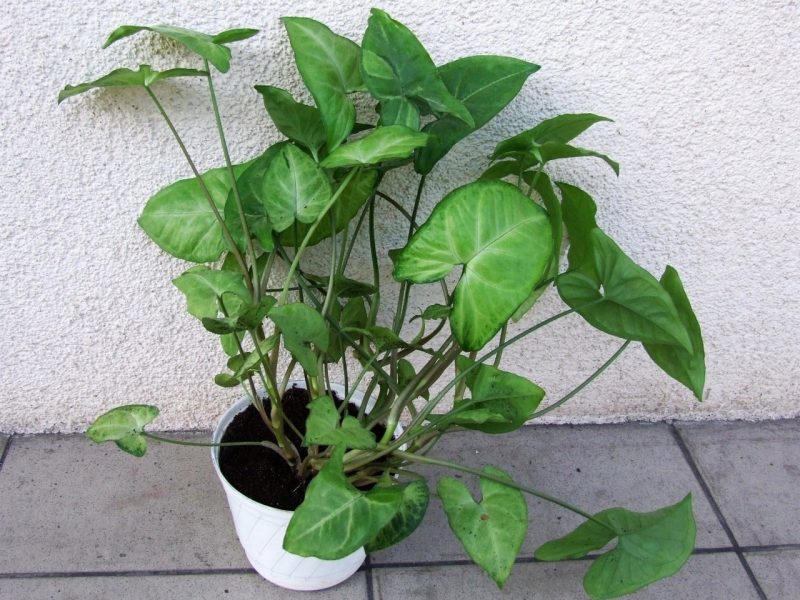
A representative of the tropical flora needs a slightly higher level of humidity, which can be achieved:
- in the summer with the help of systematic spraying with water at room temperature;
- in winter, placing the pot on a pallet with wet pebbles away from heating systems.
How to water the plant?
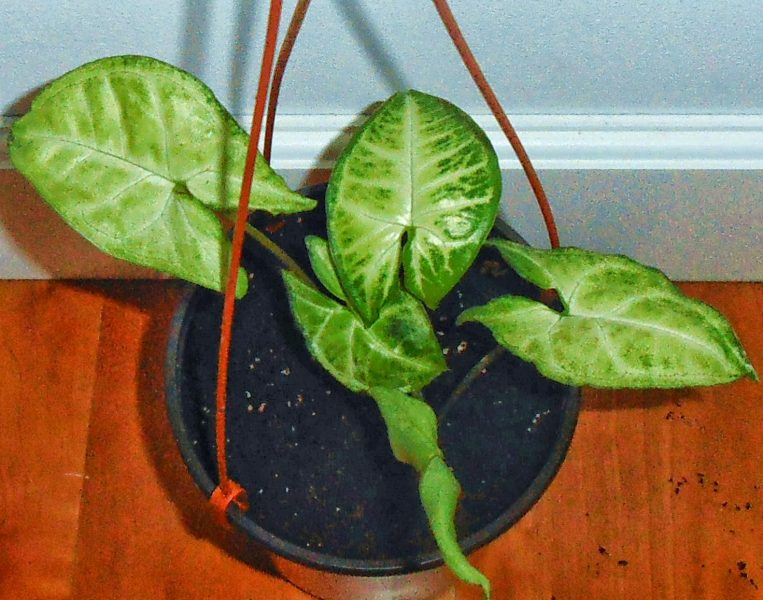
In order for the flower to have enough soil moisture without the risk of waterlogging, the plant must be watered abundantly, but only after the top layer of the substrate has dried. In winter, the frequency of watering is reduced, except in cases where the flower hibernates in hot rooms with dry air. After watering, it is recommended to monitor the pan and pour out the rest of the liquid to prevent the development of the fungus.
Advice! In order not to weaken the immunity of the plant, for irrigation, prepare purified water and slightly warm it.
Fertilizers and fertilizers
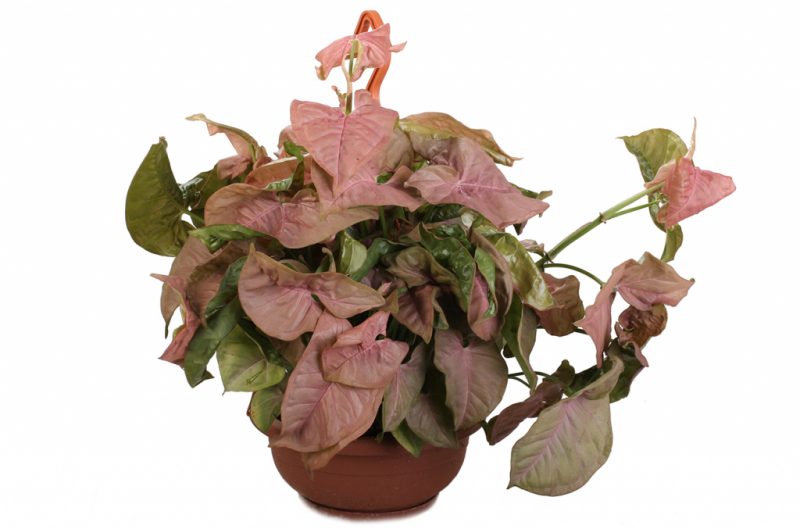
Syngonium is fed during a period of intensive growth, when it consumes the most nutrients contained in the substrate. For top dressing, which is carried out twice a month, complex mineral fertilizers with a low concentration of calcium are used.
Trimming, pinching and shaping the crown
Regular pruning of overgrown shoots will make the plant branch more strongly.
Syngonium flower can grow in the form of:
- bush - when planting several plants simultaneously in a pot;
- trees - when installing the support;
- ampelous plant - when planting a young specimen in a hanging pot.
But, despite the chosen form of growth, every spring it is necessary to carry out sanitary pruning, removing damaged, dried shoots. To stimulate branching, young plants are nipped over the sixth leaf plate.
Transplant Nuances
Intensively growing, young specimens that quickly deplete the soil need an annual transplant. Adult plants are transplanted with an interval of 3 years, when the roots appear from the drainage holes.
With the advent of spring:
- A more capacious pot is selected, at the bottom of which a layer of drainage material is placed.
- In the case of growing a tree using drainage material, a support in the form of a tube is fixed.
- Then placed a little substrate of turf, leafy land, peat and sand in equal parts.
- Syngonium with an old earthen lump is transferred onto a fresh substrate.
- The remaining space is filled with soil mixture, which is slightly compacted and moistened.
Diseases, pests and methods of dealing with them
Of the pests that are observed on a plant with weakened immunity, aphids, scale insects and thrips are of particular danger. In the process of their life, the flower begins to lose its decorative effect. To prevent this from happening, at the first sign of harmful insects, the exotic culture should be treated with an insecticidal preparation according to the manufacturer's instructions.

With excessive watering, the syngonium can be affected by a gray rot rot fungus disease, which will have to be controlled in several stages:
- The affected specimen is transplanted into a fresh substrate with the preliminary removal of the affected roots.
- The plant is treated with fungicide.
Flower propagation methods
Syngonium propagates by apical cuttings when:
- Cuttings with 2-3 internodes are cut, where at least one growth bud should be.
- Slices are treated with activated carbon.
- Cuttings are deepened in wet sand and covered with a film to create greenhouse conditions.
- In the process of rooting, the plantings are aired and moistened.
- After root formation, new plants are planted in separate pots.
Syngonium: Signs and Superstitions
You can find many signs and superstitions associated with syngonium, as in other cases and with other indoor plants. For example, it is believed that the syngonium can predict the weather: before the rain, droplets of water appear on the tips of the pointed leaf plates. As for superstitions, they can be of completely different colors. Some believe in the miraculous power of syngonium, able to overcome even the very serious illnesses of the owner.

Also, a flower is considered a symbol of knowledge, family happiness and strengthening character. Adherents of a different opinion attribute the plant to the quality of a “husband”, the growth of which in the house promises an unmarried girl to remain an old maid.
However, in reality superstitions have no scientific justification. Therefore, if the city apartment does not have enough oxygen, then the acquisition of syngonium will be an excellent solution. After all, it cleans the air of toxins, enriches it with volatile, while growing very quickly.
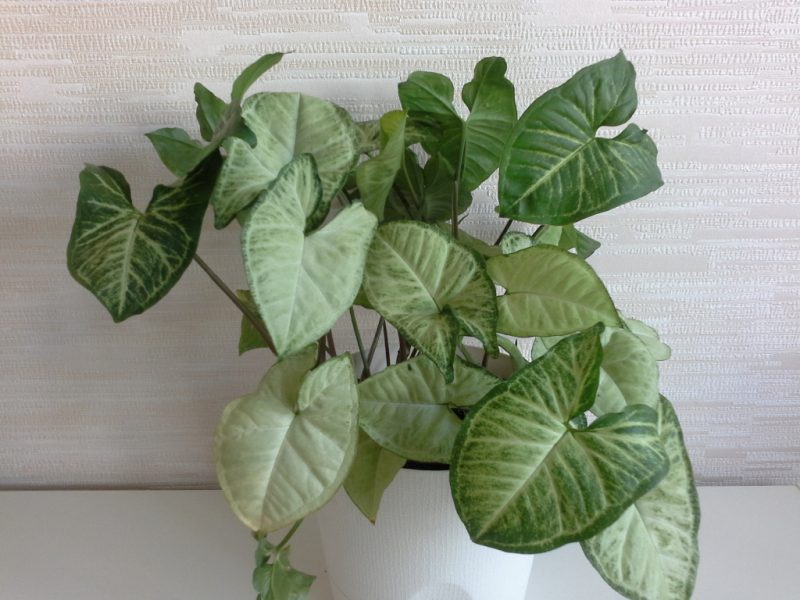
Thus, it is not difficult to grow a representative of exotic flora in a city apartment. For small efforts, the flower will thank the owner with the beauty of the colorful and bright shoots, which, in addition to aesthetic beauty, enrich the air with oxygen, strengthening the general health of all households.


